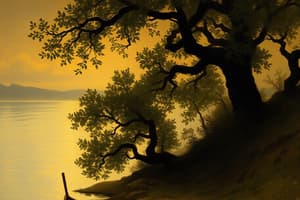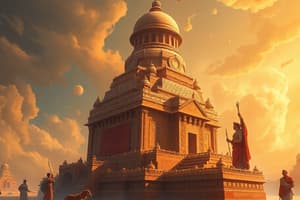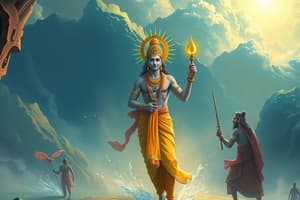Podcast
Questions and Answers
What are the four main parts of the Vedas?
What are the four main parts of the Vedas?
Rig Veda, Sama Veda, Yajur Veda, and Atharva Veda.
What is the primary focus of the Yajur Veda?
What is the primary focus of the Yajur Veda?
It deals with the procedures for performing sacrifices.
How is the Sama Veda different from the Rig Veda?
How is the Sama Veda different from the Rig Veda?
The Sama Veda consists of verses mostly taken from the Rig Veda, but they are organized for singing.
What type of content is found in the Atharva Veda?
What type of content is found in the Atharva Veda?
What distinguishes Mandals II-VII of the Rig Veda?
What distinguishes Mandals II-VII of the Rig Veda?
What period is referred to as the Vedic Age?
What period is referred to as the Vedic Age?
What does the term 'Arya' signify in the context of the Rig Veda?
What does the term 'Arya' signify in the context of the Rig Veda?
What is the basis of the European Theory regarding the origin of the Aryans?
What is the basis of the European Theory regarding the origin of the Aryans?
Name one linguistic similarity that supports the European Theory.
Name one linguistic similarity that supports the European Theory.
Who was a significant figure in the development of the European Theory of Aryan origin?
Who was a significant figure in the development of the European Theory of Aryan origin?
What does the Central Asian Theory suggest about the Aryans' origin?
What does the Central Asian Theory suggest about the Aryans' origin?
Which evidence supports the Arctic Region Theory regarding Aryan origins?
Which evidence supports the Arctic Region Theory regarding Aryan origins?
How do the Vedas indicate the Indian origin of the Aryans?
How do the Vedas indicate the Indian origin of the Aryans?
What archaeological culture provides evidence for the migration of Indo-Aryans to India?
What archaeological culture provides evidence for the migration of Indo-Aryans to India?
What are the two main divisions of Vedic literature?
What are the two main divisions of Vedic literature?
Which scholars support the Indian Theory of Aryan origins?
Which scholars support the Indian Theory of Aryan origins?
Which texts are included in Early Vedic literature?
Which texts are included in Early Vedic literature?
What is the significance of the term 'Veda'?
What is the significance of the term 'Veda'?
Which rivers were crucial to the early Aryan settlement in the Sapta Sindhu region?
Which rivers were crucial to the early Aryan settlement in the Sapta Sindhu region?
What was the military technology that gave the early Aryans an advantage?
What was the military technology that gave the early Aryans an advantage?
Flashcards
Vedic Age
Vedic Age
A period in Indian history (1500-500 BCE) primarily reconstructed from Vedic texts.
Indo-Aryans
Indo-Aryans
Linguistic group, speakers of a branch of Indo-European languages.
Rigveda
Rigveda
Ancient Indian text, important source for information about the Vedic Age.
Arya (in the Rigveda)
Arya (in the Rigveda)
Signup and view all the flashcards
Origin of Aryans
Origin of Aryans
Signup and view all the flashcards
Sama Veda
Sama Veda
Signup and view all the flashcards
Yajur Veda
Yajur Veda
Signup and view all the flashcards
Atharva Veda
Atharva Veda
Signup and view all the flashcards
Vedas
Vedas
Signup and view all the flashcards
Vedic Corpus
Vedic Corpus
Signup and view all the flashcards
Early Vedic Literature
Early Vedic Literature
Signup and view all the flashcards
Later Vedic Literature
Later Vedic Literature
Signup and view all the flashcards
Sapta Sindhu
Sapta Sindhu
Signup and view all the flashcards
Horse Chariots
Horse Chariots
Signup and view all the flashcards
Central Asian Theory
Central Asian Theory
Signup and view all the flashcards
Arctic Region Theory
Arctic Region Theory
Signup and view all the flashcards
Indian Theory
Indian Theory
Signup and view all the flashcards
Andronovo Culture
Andronovo Culture
Signup and view all the flashcards
Aryans, Where Did They Come From?
Aryans, Where Did They Come From?
Signup and view all the flashcards
Study Notes
The Vedic Age (Rig Vedic and Later Vedic)
-
Harappan culture was followed by a culture known as Vedic. This reconstruction is primarily based on using Vedic texts as sources. However, recently, archeological sources have also been adopted to completely comprehend the Indo-Aryans.
-
The term "Indo-Aryans" is linguistically based, though not necessarily historically.
-
Rig Veda composers describe themselves as Ârya. The term is etymologically derived from a Sanskrit word meaning to cultivate, literally kinsmen or companions.
-
The different theories are as follows:
Theory
- European Theory: The continent of Europe is the original home of the Aryans. On the basis of comparative linguistics, comparisons among Greek, Latin, Germanic, and Sanskrit are used. Specific similarities and cognates between words like "mati" and "pitri" are noted.
Postulates
- Continent of Europe: The continent of Europe is the home of the Aryans.
- Comparative Linguistics: Comparisons among Greek, Latin, Germanic, and Sanskrit are highlighted, finding similarities and common ancestors of words.
Supported by
- Sir William Jones (1786)
- Giles (Hungary)
- Schroeder (France)
- P. Nehruing (Steppes (S. Russia))
- Morgan (Western Siberia)
Studying That Suits You
Use AI to generate personalized quizzes and flashcards to suit your learning preferences.




